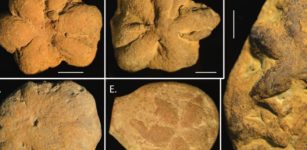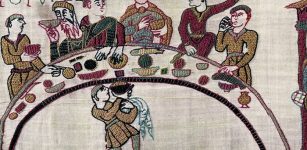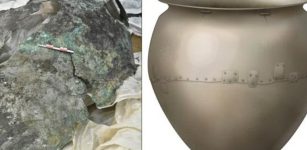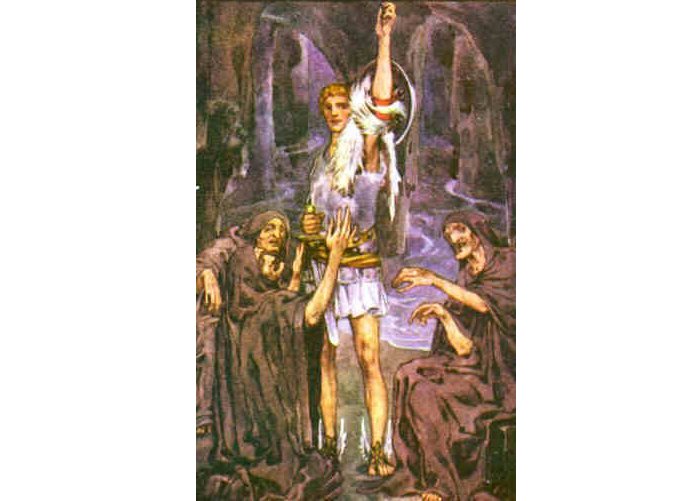Graeae: Three Sisters Of Fate Who Shared One Eye And Tooth In Greek Mythology
A. Sutherland - AncientPages.com - The Graeae were three sisters of fate who shared one eye and one tooth in Greek mythology. They were born as old women and their names were Deino (dread), Enyo (horror), and Pemphredo (alarm).
The number three is of great symbolical meaning in many myths. The Graeae share certain similarities with the three Norns, known as ‘Shapers of Destiny’ in Norse mythology. The Norns were goddesses who ruled the fates of people, determined the destinies and lifespans of individuals.
One might also compare the Graeae with the three spinners of Destiny, the Moirai who were also called the Fates in Greek mythology. The three Moirai determined the span of life of every mortal from birth to death. They were so powerful that no god had the right or the means to alter their decisions.
Although the Fates were the personifications of destiny, no human could blame the fates, as he was the only one responsible for his failures.
The Graeae were three sisters of fate who shared one eye and one tooth in Greek mythology. Image credit: Doorway To Other Worlds
The subject of fate is also reflected in Baltic religion where we encounter Laima, the Baltic goddess of fate who together with Dievs, the sky, and Saule, the sun, Laima determines the length and fortune of human life.
The mythical story of the Graeae has changed over the course of time. In their original conception, they were merely personifications of kindly and venerable old age, possessing all its benevolent attributes without its natural infirmities.
They were old and gray from their birth, and so they ever remained. In later times, however, they came to be regarded as misshapen females, decrepit, and hideously ugly, having only one eye, one tooth, and one gray wig between them, which they lent to each other when one of them wished to appear before the world. So, at times poets described them as "beautiful."
In other legends they are described as being half-swan or old, ugly hags. Their age was so great that a human childhood for them was hardly conceivable.
Born as the daughters of the Sea Gods, sea gods Phorcys and Ceto, and sisters of the Gorgons, the Graeae were powerful creatures and they appear in the myth of Perseus, the hero who killed Medusa, a monster, a Gorgon, generally described as a winged human female with a hideous face and living venomous snakes in place of hair. Gazers on her face would turn to stone.
Perseus Returning the Eye of the Graeae by Henry Fuseli
According to an ancient legend, Perseus was sent by the king to get Medusa's head. Perseus went to the three Graeae, that shared one eye between them, and through stealing it he made them tell him where the nymphs of the north lived. They gave him winged sandals, a magic bag that fit anything put in it, and Hades' cap which made him invisible whenever he wore it. Hermes gave him an unbreakable sword, and Athena a shield.
Perseus took the eye from the Graeae to kill Medusa.
With all this equipment, Perseus managed to kill Medusa by looking at her through the reflection of the shield and escaped her sisters by wearing the cap. His winged sandals flew him home. Later he offered Medusa's head to Athena.
The Graeae are also called Grey Sisters, Graiai, and Graiae.
Written by – A. Sutherland AncientPages.com Staff Writer
Copyright © AncientPages.com All rights reserved. This material may not be published, broadcast, rewritten or redistributed in whole or part without the express written permission of AncientPages.com
Expand for referencesEdith Hamilton, Mythology: Timeless Tales of Gods and Heroes
Bernard Evslin, Heroes, Gods and Monsters of the Greek Myths
More From Ancient Pages
-
 28,000-Year-Old Lapedo Child: Human-Neanderthal Hybrid Reveals A Prehistoric Secret
Evolution | Mar 10, 2025
28,000-Year-Old Lapedo Child: Human-Neanderthal Hybrid Reveals A Prehistoric Secret
Evolution | Mar 10, 2025 -
 Death And Afterlife In Ancient Egyptian Beliefs – Death As Transition To Another Reality
Featured Stories | May 28, 2018
Death And Afterlife In Ancient Egyptian Beliefs – Death As Transition To Another Reality
Featured Stories | May 28, 2018 -
 Mysterious Ancient Star-Shaped ‘Fossil’ Baffles Scientists – What Is It?
Archaeology | Feb 27, 2023
Mysterious Ancient Star-Shaped ‘Fossil’ Baffles Scientists – What Is It?
Archaeology | Feb 27, 2023 -
 How And When Did Ancient People Start Using Oil?
Ancient History Facts | Jun 28, 2018
How And When Did Ancient People Start Using Oil?
Ancient History Facts | Jun 28, 2018 -
 Home Of Jesus’ Apostles Found In The Lost Biblical Town Bethsaida
Archaeology | Aug 10, 2017
Home Of Jesus’ Apostles Found In The Lost Biblical Town Bethsaida
Archaeology | Aug 10, 2017 -
 Wonderful And Unique Viking Silver Treasure Uncovered In Täby In Stockholm, Sweden
Archaeology | Nov 29, 2022
Wonderful And Unique Viking Silver Treasure Uncovered In Täby In Stockholm, Sweden
Archaeology | Nov 29, 2022 -
 Curly Hair Protected The Brain Of Early Humans And Helped It Grow
Human Beginnings | Aug 31, 2023
Curly Hair Protected The Brain Of Early Humans And Helped It Grow
Human Beginnings | Aug 31, 2023 -
 Unusual Underwater Archaeological Discovery In California May Confirm Thousand-Year-Old Legend And Re-Write Ancient History
Featured Stories | Aug 15, 2024
Unusual Underwater Archaeological Discovery In California May Confirm Thousand-Year-Old Legend And Re-Write Ancient History
Featured Stories | Aug 15, 2024 -
 10 Remarkable Ancient Indian Sages Familiar With Advanced Technology And Science Long Before Modern Era
Featured Stories | Oct 19, 2015
10 Remarkable Ancient Indian Sages Familiar With Advanced Technology And Science Long Before Modern Era
Featured Stories | Oct 19, 2015 -
 On This Day In History: Declaration Of Arbroath – The Scots Reaffirm Their Independence – On Apr 6, 1320
News | Apr 6, 2016
On This Day In History: Declaration Of Arbroath – The Scots Reaffirm Their Independence – On Apr 6, 1320
News | Apr 6, 2016 -
 How Did Sea Level Rise Impact Human Groups During Mesolithic And Neolithic Periods?
Archaeology | May 20, 2022
How Did Sea Level Rise Impact Human Groups During Mesolithic And Neolithic Periods?
Archaeology | May 20, 2022 -
 Rare 1,600-Year-Old Wooden Pagan Idol Discovered In Ireland
Archaeology | Aug 16, 2021
Rare 1,600-Year-Old Wooden Pagan Idol Discovered In Ireland
Archaeology | Aug 16, 2021 -
 Bayeux Tapestry: Original Location Of Remarkable Romanesque Art – Finally Solved
Archaeology | Oct 26, 2019
Bayeux Tapestry: Original Location Of Remarkable Romanesque Art – Finally Solved
Archaeology | Oct 26, 2019 -
 Mysterious Biblical Celestial City And Its Connection To The North Star – The Arrival – Part 2
Biblical Mysteries | Feb 26, 2021
Mysterious Biblical Celestial City And Its Connection To The North Star – The Arrival – Part 2
Biblical Mysteries | Feb 26, 2021 -
 Unusually Arranged Skeletons And Artifacts Found Inside A 1,500-Year-Old Tomb In Berenice Troglodytica, Egypt
News | May 27, 2022
Unusually Arranged Skeletons And Artifacts Found Inside A 1,500-Year-Old Tomb In Berenice Troglodytica, Egypt
News | May 27, 2022 -
 Acheulian Culture Of Ethiopian Highlands And Their Prehistoric Tool Selection To Make Society’s Life Easier
Archaeology | Jan 10, 2025
Acheulian Culture Of Ethiopian Highlands And Their Prehistoric Tool Selection To Make Society’s Life Easier
Archaeology | Jan 10, 2025 -
 Unsolved Enigma Of The Inga Stone And Its Mysterious Ancient Undeciphered Signs
Artifacts | Jan 18, 2015
Unsolved Enigma Of The Inga Stone And Its Mysterious Ancient Undeciphered Signs
Artifacts | Jan 18, 2015 -
 Bronze Age Metal Cauldrons Show What Ancient People Ate
Archaeology | Aug 19, 2023
Bronze Age Metal Cauldrons Show What Ancient People Ate
Archaeology | Aug 19, 2023 -
 23,000-Year-Old Footprints Are Earliest Evidence Of Human Activity Found In The Americas
Archaeology | Sep 23, 2021
23,000-Year-Old Footprints Are Earliest Evidence Of Human Activity Found In The Americas
Archaeology | Sep 23, 2021 -
 Sumerian ‘Mask Of Warka’ From Uruk: Sculptured Face May Depict Goddess Inanna
Featured Stories | Sep 15, 2016
Sumerian ‘Mask Of Warka’ From Uruk: Sculptured Face May Depict Goddess Inanna
Featured Stories | Sep 15, 2016



